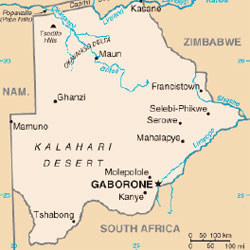Botswana is located in the heart of Southern Africa; its neighbours include Namibia, Angola, Zambia and Zimbabwe. Botswana is different in many ways from some of its neighbours, it has a good income which mainly comes from diamonds and it has a stable democratic government based on the Westminster system.
 Botswana is a relatively large country (approx 580,000 square kilometres), which is about the same size as France. With a small population spread over a vast area, don’t expect to find many big cities. The capital, Gaborone is the largest with a population of around 250,000. Gaborone is situated in the South East and is a modern African city with a good road system, shops, accommodation and a strong infrastructure. Francistown is the second‐largest city and is situated in the North East of the Country. Both these areas are a key focus for Cricket Without Boundaries projects.
Botswana is a relatively large country (approx 580,000 square kilometres), which is about the same size as France. With a small population spread over a vast area, don’t expect to find many big cities. The capital, Gaborone is the largest with a population of around 250,000. Gaborone is situated in the South East and is a modern African city with a good road system, shops, accommodation and a strong infrastructure. Francistown is the second‐largest city and is situated in the North East of the Country. Both these areas are a key focus for Cricket Without Boundaries projects.
The main difference between the groupings of people across Botswana is the language spoken. Although English is the official language, it is Setswana that is the most common language as it is understood by 80% of the population.
There are more than 20 other languages spoken throughout Botswana. Rest assured though, you will find that English is the main language used for instruction within secondary schools, so there will be a good level of understanding as you try to explain cricket drills and if there isn’t that just adds to the fun and challenge of the trip!
As far as cricket goes, it was started in the country by expatriates from South Africa and the Indian subcontinent. Botswana was elected to the ICC as an affiliate member in 2001. Botswana Cricket Association is the official governing body of the sport of cricket in Botswana. Its current headquarters is in Gaborone, Botswana. It is also a member of the African Cricket Association. The Botswana National team are currently in Division Six of the ICC World Cricket League.
Why are CWB in Botswana?
Botswana has been hit hard by AIDS. In 2009 there were an estimated 300,000 adults living with HIV; or one quarter of the population aged 15 and over. Considering Botswana’s population is below two million, the epidemic has reached disturbing proportions. The country has an estimated adult HIV prevalence among 15‐49 year olds of 24.8%, the second highest in the world1.
HIV and AIDS has had a devastating impact on Botswana. Life expectancy at birth fell from 65 years in 1990‐1995 to less than 40 years in 2000‐2005, a figure about 28 years lower than it would have been without AIDS2.
1 UNAIDS (2010), UNAIDS report on the global AIDS epidemic’
2 The Impact of AIDS”, United Nations, 2004
Be First to Comment